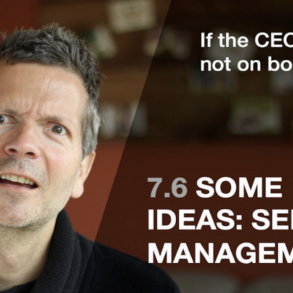Originally written by by Gregory Ferenstein and published on Fast Company, adapted from a Medium.com post
The company estimates about half of those who took the Holacracy-related severance wanted to “pursue other passions.”
A version of this article originally appeared on Medium; it has been edited for length and clarity.

For the past two years, quirky culture enthusiast and Zappos CEO Tony Hsieh has fascinated the business press with his radical experiment in self-governing management. Early on, I did a feature on their so-called “Holacracy” management method (called “teal” internally), which abolishes traditional hierarchy and replaces bosses with an overlapping network of self-managed teams. Employees were encouraged to accept the changes, or to take a generous severance package and leave.
After numerous press reports about an exodus of employees from the company (the New York Times reported that 18% of the company, or some 260 people, had left since last March), I reached out to Hsieh and his team for a response. Questions were answered via email. Below is our interview, edited for clarity and brevity. (The full responses to all of the questions can be read on a public Google doc here.)
GREG FERENSTEIN: Generally speaking, how would you characterize the accuracy of the latest round of press on departures from Zappos?
FRED MOSSLER, NON-TITLED ZAPPOS EXECUTIVE: As I noodle on the press coverage, what no one has mentioned, is if any company were bold enough to offer their entire employee base a severance the likes of which we did, what percent of any other company’s employees do you think would take the offer? In reading all the exit interviews and speaking with people leaving, the exodus is less about Holacracy/dissatisfaction and more about the opportunity to pursue other passions or fulfill other goals in life. The fact we can make such an offer and only 18% choose to leave is I’m guessing an impressive statistic in the corporate world.
TONY HSIEH: I completely agree with Fred… the ironic thing is that we didn’t actually have to make an offer. The reason we did was because it’s always been a part of our culture to treat our employees well and is consistent with our ongoing practice of making every single new employee an offer of several thousand dollars to quit the company during our 5-week new hire training. The headline really should be “82% of employees choose NOT to take the offer.”
Here’s the data that most of the articles did not include for proper context:
- Zappos annual turnover in 2013 and 2014 was each about 20%
- Teal Offer takers totaled about 18% (including the delayed Super Cloud Teal Offer takers)
- Our estimate is that roughly half of the Teal Offer takers took the offer not because of anything related to Holacracy or Teal, but because the economics of the offer were too good to pass up (minimum of 3 months severance or 1 month for every year worked (whichever was greater). Some long-time employees were offered over a year of severance, plus they are still eligible to join Zappos again after 12 months, so it allowed people the opportunity to pursue their new startup ideas, or take time off to take care of their sick relative, for example.
- Our total turnover for 2015 was about 30%
- Based on the above numbers, our extra turnover was about 10% more in 2015 compared to what’s normal, and that 10% was mostly due to us giving long-time employees the opportunity to pursue their dreams (average severance paid out was about 5.5 months pay when we last analyzed the data).
And finally, a misinterpreted conversation with our COO Arun (Rajan) resulted in reports suggesting that we would have had a layoff if enough folks had not taken the offer. This is factually incorrect.
The FAQ says that Zappos had an annual turnover of about 20%. Isn’t this unusually high? I thought Zappos was a place where people stick around, especially considering your company culture. Has it always been around 20%, or has something changed over the years?
HSIEH: Our annual turnover has generally been around 20% (except for 2015 due to the Teal Offer). A quick Google search suggests this is well below the turnover for most call centers, but regardless, our goal has never been to hit a certain turnover metric. Instead, our goal is to maximize the number of employees that believe in the company mission, are passionate about customer service, and believe that this is the right culture for them.
This is why we make an offer to every single new hire (regardless of department) during their 5-week new hire training class, for example. We offer every new hire several thousand dollars to quit and leave the company before they start the actual job they were hired for. This obviously will increase our turnover compared to if we didn’t make the offer, but we think it’s the right thing to do to make sure employees don’t feel “stuck” in a job or company that’s not the right fit for them.
I think what strikes people about the Holacracy story is that Zappos was a generally successful company. I think the media is used to stories about radical restructuring only when there’s some serious issue. Why did you take such a big risk when everything was going (relatively) OK? Or, did you anticipate some problems down the road that weren’t immediately apparent about the company?
HSIEH: I think the real question should be about what happens if there is no innovation on how companies are structured? This isn’t just about Zappos, this is about all companies. The default future for companies under the traditional structure is death. Something like 88% of the companies that were on the Fortune 500 list in 1955 are no longer on that list.
The simple fact is that command and control structures do not stand the test of time, but self-organized and self-managed structures (such as cities) are resilient and do stand the test of time.
In addition, research has shown that every time the size of a city doubles, innovation or productivity per resident increases by 15%. But with traditional companies, the opposite happens — innovation or productivity per employee generally goes down.
Holacracy just happens to be the technology that we are using today, but our ultimate goal is that we want to structure Zappos more like a city and less like a top-down bureaucratic command and control organization.
Our march towards self-organization and self-management isn’t an experiment. It’s the future of work and it’s the only structure that has stood the test of time. It’s the only structure that can become more innovative as it gets bigger (vs. typical corporate structures that become less innovative as they get bigger). Self-organization and self-management isn’t a theory. It exists in nature, and it exists in human-created cities.
At 1,500 people, we just generally felt like things were moving slower compared to when we were 150 people. I don’t think it’s really anyone’s fault, I think it’s a byproduct of the normal hierarchical structure and processes. There’s never a good time to make a change like this, but I can tell you that it would have been a lot harder to do at 15,000 people than 1,500 people, though I wish we had done it earlier.




